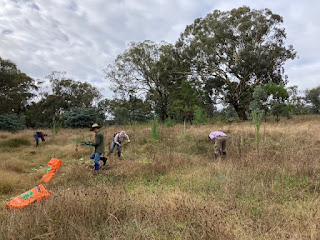Mt Rogers scheduled working bees are on Sunday 27th March and Monday 4th April. Each starting at 09.00am.
For Sunday please park in the eastern arm of Schwarz Place, Flynn. We have gaiters and some gloves but it would help if you bring your secateurs.
Today (22 March) I had a walk mostly across country and felt further despondency at the contrast between the wooded sections and the more open spaces in terms of the principal weed species that have thrived on the La Nina weather systems’ rain events.
Most numerous are the Fleabanes (left x2), then Prickly Lettuce (right x2) both members of the ‘daisy’ family and with seeds that ‘parachute’ away on the slightest breeze now that they are ripe.
Slightly less obvious and species volunteers have also worked on managing are the recognisable purple Thistle and the yellow-flowered spike of the Verbascum or Mullein.
The rehydrated soils have stimulated mass germination of these and other less obvious introduced species. Some species’ seeds can remain viable in the soil for decades. Trillions have grown around the ACT, the region and beyond. This season’s seeds will top-up the seed bank awaiting conducive conditions in the future. 

I waded through the tall grasses along the tracks kangaroos have made when traversing the reserve over the decades eventually heading towards an ancient eucalypt that was surrounded by a huge spread of Honeysuckle until we overcame it.
I noticed someone had tied a nest box to another gum tree. It had a large 7-8cm circular opening facing north east. I was musing “Which species is the installer trying to attract”, when there were some almost cockatoo-like shrieks of annoyance.
I looked up to see two agitated Galahs flapping wings and shrieking. Simultaneously a slumber-disturbed Sugar Glider exited the nest box and ran away around the trunk. I realised the glider had disappeared as the Galahs calmed down, resuming their eleven o’clock routine on the tree’s huge branches.
When we worked on the Honeysuckle there was a pair of Galahs present. Presumably today’s Galahs were that same pair.
I made my way across towards the summit with renewed hope after that, lighter steps through the rank grasses being impossible.
Near Snow Gum Corner in the reserve’s south east there were many small birds in the canopy of a huge Apple Box eucalypt. They were feeding and calling, each species with its own musical phrases of contact calls for keeping in touch.
As some of the birds flew close to Schwarz Place’s trees I noticed two diving down to the shorter native grasses. Scarlet Robins back to Mt Rogers for the cooler months…when Tuesday (23 March) is to be 29 degrees!
Thank you,
Rosemary
P.S. At our last session near the Tree of Heaven site, we found that a wooden bench seat had been installed to take in the magnificent views. The seat had been taken from near the Benchmark tree 150m away where everyone could enjoy a shaded rest. Now people would need serious, weed-repellent gear to reach the seat.




